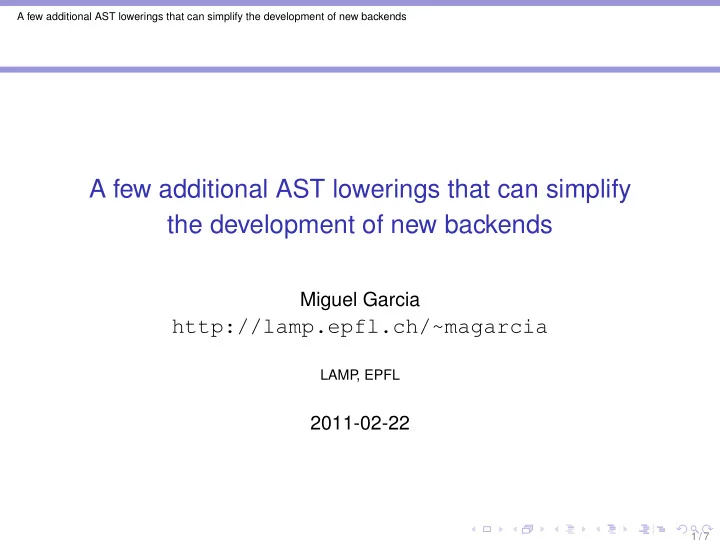

A few additional AST lowerings that can simplify the development of new backends A few additional AST lowerings that can simplify the development of new backends Miguel Garcia http://lamp.epfl.ch/~magarcia LAMP , EPFL 2011-02-22 1 / 7
A few additional AST lowerings that can simplify the development of new backends Outline Elevator pitch Status Quo Hidden opportunities for reuse (lots of) Fine print: SSA, Testing, and genuine platform dependencies Revisiting the Elevator Pitch 2 / 7
A few additional AST lowerings that can simplify the development of new backends Elevator pitch ◮ There is a way to reduce the effort it takes to develop a new backend for Scala ◮ How? By factoring out those AST lowerings that are shared across different backends (otherwise, each backend developer must handle them anew) ◮ Moreover, developers of non-backend compiler plugins also stand to benefit from this approach. 3 / 7
A few additional AST lowerings that can simplify the development of new backends Status Quo A brief history (so far) of non-VM backends: ◮ CSharpGen 1 ◮ Goal: emitting C# 3.0 source files, acting as a drop-in replacement of GenICode → GenMSIL ◮ Input: BlockExpr -free, OO code (“structured GOTO” allowed.) ◮ Status: Assigned to community ◮ Geoffrey Reedy’s Scala to LLVM 2 ◮ Goal: emitting LLVM IR ◮ Input: SSA (procedural 3-Address instr with phi-nodes in CFGs) ◮ Status: Under development ◮ The mythical Scala to Java translator ◮ Goal: emitting Java 1.5 source files ◮ Input: GOTO-less, BlockExpr -free, OO code. ◮ Status: Abandoned 1 http://lamp.epfl.ch/~magarcia/ScalaNET/2011Q1/CSharpGen.pdf 2 http://greedy.github.com/scala/ 4 / 7
A few additional AST lowerings that can simplify the development of new backends Hidden opportunities for reuse (lots of) What-if the following post-CleanUp transformations were available: 1. GOTO elimination 3 (implemented 50%) rephrases ASTs containing arbitrary jumps into ASTs containing ◮ structured control flow constructs, plus ◮ additional boolean variables to pick the original execution paths. 2. BlockExpr desugaring: flatten block expressions, assign value to variable and use later. 3. Explicit eval order: again by assigning to temporary variables. Useful to rule out wrong-order in “source-language backends". For example: “ x() + y() * z() ” vs. “ x() + (y() * z()) ” Taken together, they bring the AST into GOTO-less 3-Address form. 3 http://lamp.epfl.ch/~magarcia/ScalaCompilerCornerReloaded/2011Q1/JumpsRemover.pdf 5 / 7
A few additional AST lowerings that can simplify the development of new backends Fine print: SSA, Testing, and genuine platform dependencies What about SSA (details on backup slide) ◮ Tree nodes can’t represent SSA explicitly , so we stop rewriting. In any case, SSA from 3-Address not harder than from bytecode: SSA-functional connection “at hand” after previous rewritings. A straightforward way to check whether lowerings preserve semantics ◮ let GenICode → GenJVM run as usual afterwards Granted, some unavoidable (genuine) platform adapting still needed (a barrier that platform gurus can tackle with far less compiler mojo) Platform assumptions (SLS Ch. 12) TODO: Porting Guide of scalac 6 / 7
A few additional AST lowerings that can simplify the development of new backends Revisiting the Elevator Pitch A small number of (post-CleanUp) AST lowerings: 1. GOTO elimination 2. BlockExpr flattening 3. making eval order explicit pave the way to a large number of new backends: ◮ C# 3.0, Java 1.5, “low-level JavaScript” (ditto for ActionScript) ◮ program verification backends (in particular, Spec#) ◮ LLVM, Google Native Web Client ◮ Android NDK (Native Development Kit), Apple iOS ◮ other “embedded” VMs (tablets, etc.) ◮ Google @ Game DevCon: google.com/events/gdc/2011/agenda.html and that’s without counting the SSA-functional connection! :-) 7 / 7
A few additional AST lowerings that can simplify the development of new backends Appendix: Biblio on SSA Appendix (1 of 2): Bibliograpy for slide 6 (SSA) ◮ A. Gal, Ch. W. Probst, and M. Franz Structural Encoding of Static Single Assignment Form 4 ◮ Navindra Umanee: SOOT Shimple: An Investigation of SSA 5 ◮ W. Amme, N. Dalton, J. von Ronne, and M. Franz SafeTSA: A Type Safe and Referentially Secure Mobile-Code Representation Based on Static Single Assignment Form ◮ Section on “functional" in this 6 SSA bibliography ◮ Marius Nita’s A Functional Intermediate Form for Soot 7 4 http://dx.doi.org/10.1016/j.entcs.2005.02.045 5 http://www.sable.mcgill.ca/publications/thesis/masters-navindra/ sable-thesis-2006-masters-navindra-double-sided.pdf 6 http://www.cs.man.ac.uk/~jsinger/ssa.html 7 http://web.cecs.pdx.edu/~marius/files/hw/grad_compilers/results.pdf 8 / 7
A few additional AST lowerings that can simplify the development of new backends Appendix: Biblio on CLR native compilers Appendix (2 of 2): Bibliography for slide 7 (native compilers) ◮ Unlike for Android, native development only with partner-license: ◮ Windows Phone 7 ◮ Silverlight ◮ XNA (Xbox 360). Note: the Xbox “1.0” had a C++ XDK 8 . ◮ What defines those platforms instead is the base framework , e.g. for XNA it’s a subset of the .NET Compact Framework . ◮ Assemblies relying on a platform’s base framework can run on it: ◮ F# for Game Development 9 ◮ Using XNA Game Studio with other programming languages 10 ◮ NGEN can compile those assemblies into (platform-specific) executable images 11 , but JITting is on par except for startup time. 8 http://en.wikipedia.org/wiki/Xbox_Development_Kit 9 http://sharp-gamedev.blogspot.com/ 10 http://forums.create.msdn.com/forums/p/1464/7267.aspx 11 http://en.wikipedia.org/wiki/Native_Image_Generator 9 / 7
Recommend
More recommend